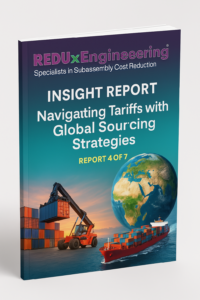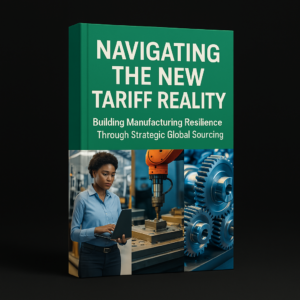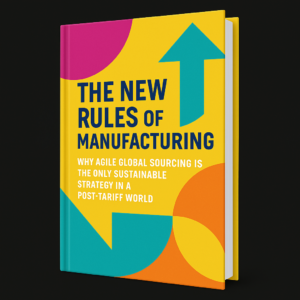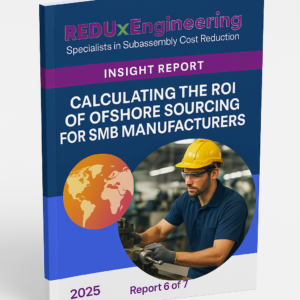
Introduction:
The landscape shifted on April 2, 2025, when the U.S. announced sweeping new import tariffs (a baseline 10% on virtually all imports, with higher rates like 20% on EU goods). For manufacturers in Western Europe, Canada, the UK, and other U.S.-allied regions, these tariffs felt like a direct blow – effectively a tax on goods you export to the U.S. market. This report discusses how diversified global sourcing can serve as a tariff mitigation strategy. We’ll provide context on the tariff changes and then outline practical responses: reconfiguring supply chains to maintain profit margins despite the tariffs. The surprising conclusion is that, with smart sourcing, many companies can offset the tariff impact entirely – and even turn it into a net advantage.
Tariff Impact 101:
The new U.S. policy (branded “Liberation Day” tariffs) instituted a minimum 10% tariff on all imports, plus steeper penalties on specific countries (e.g. 20% on EU, 34% on China). For a Western manufacturer selling into the U.S., this means your products now cost 10–20% more upon entry than they did previously. Without any adjustments, that hits your bottom line hard – either your U.S. customers pay more (potentially hurting sales volume) or you have to absorb the tariff cost in your pricing (hurting margins). It’s essentially a forced cost increase. Understandably, many firms considered moving production into the U.S. to avoid tariffs. But as discussed earlier, onshoring fully to the U.S. comes with much higher production costs – often wiping out any tariff avoidance benefit. In fact, REDUxEngineering analysis shows that a Western European manufacturer that onshores to the U.S. could end up with zero net savings, because what they save on tariffs they lose in higher U.S. costs. Meanwhile, those who stick with efficient offshore sourcing of components can often neutralize the tariff. How? By ensuring their cost savings on parts are greater than the tariff rate.
Offsetting Tariffs with Cost Savings:
Here’s a powerful statistic: for companies in Western Europe, Canada, etc., offshoring parts and subassemblies can yield 19%–49% cost savings, as noted earlier. That range comfortably exceeds the 10% U.S. tariff, and even the higher 20% tariff on EU goods falls within that window. In practical terms, if you restructure your supply chain so that key components are made in low-cost countries (China, India, Vietnam, Philippines, etc.), you might reduce your unit costs by, say, 30%. Now, when you assemble the final product and ship it to the U.S., you pay a 10% import tariff – but you’re still 20% ahead on cost overall. REDUxEngineering summarized it well: “With the blanket 10% tariff on your sales into the US, the 19%–49% savings through offshore sourcing is the difference between losing 10% off your profit line and gaining 9% to 39% on those same sales.”. In other words, a strategic global sourcing program can not only absorb the tariff impact, but actually improve your margins in the process.
To illustrate: A Canadian hardgoods manufacturer was facing the 10% U.S. tariff on a product line. They engaged REDUxEngineering to cut costs on several metal and plastic components in that product. By moving those parts to suppliers in India and Vietnam, they achieved a 25% cost reduction on the component level. By the time the finished goods shipped to the U.S. and incurred 10% duty, the company still realized roughly 15% net cost savings versus their pre-tariff baseline. Instead of a hit, they saw their U.S. sales become more profitable than before the tariff. This kind of outcome is quite achievable with careful planning.
Tariff Engineering – Supply Chain Reconfiguration:
In some cases, it’s not just about sourcing from cheaper countries, but also re-routing supply chains to minimize tariff exposure. For example, the April 2025 U.S. tariffs hit EU goods with 20%, but goods from certain other countries (say Vietnam or Mexico) might only face the base 10% or even be exempt under trade agreements. Manufacturers can consider locating final assembly or sourcing subcomponents in countries with more favourable trade status. One strategy is known as “country of origin diversification.” If your product can be partially assembled in, say, Southeast Asia, and then shipped directly to the U.S., you might avoid the higher regional tariff. (This must be done in compliance with rules-of-origin laws – essentially ensuring substantial transformation occurs in the low-tariff country.) Another approach is splitting your production: keep serving your non-U.S. markets from your home facility, but establish an offshore manufacturing flow dedicated to U.S.-bound products. This way, the volume affected by tariffs is produced in a tariff-friendly manner from the start.
Case in point:
A UK industrial equipment maker faced a 20% U.S. tariff. They set up an arrangement where critical subassemblies were produced in the Philippines and then shipped directly to the U.S. as service parts or kits, bypassing the UK origin penalty and enjoying dramatically lower labour and raw material costs. For their fully assembled products, they actually shifted final assembly to a partner plant in Vietnam. That plant would receive components from both the UK and various Asian sources, assemble the finished machine, and then ship to U.S. customers labelled “Made in Vietnam” (subject to a potentially zero tariff if a deal is struck). This reconfiguration required logistical changes but resulted in roughly 15% total cost reduction for U.S. shipments, even after tariffs – whereas doing everything in the UK and taking a 20% tariff would have wiped out their profit. It demonstrates how agile supply chain design can blunt the force of trade barriers.
Tariff Volatility and Long-Term Strategy:
Another argument for maintaining an offshore sourcing strategy is the volatility of tariffs. Trade policies can and do change. The 2025 tariffs themselves are a product of political decisions, and they could be rolled back in the future. Indeed, within 48 hours of the April announcement, there were already talks of potential deals (e.g. the U.S. and Vietnam discussed removing tariffs after quick negotiations). Betting your whole strategy on a tariff regime can be risky – you might invest heavily to onshore, only for the tariffs to disappear a year later, leaving you stuck with a high-cost structure. By contrast, a diversified global approach provides flexibility. If tariffs remain, you’ve set up a cost-efficient supply chain that can handle it (as described above). If tariffs are reduced or eliminated, then your offshore-produced goods suddenly gain an even bigger cost advantage (restoring the full ~20–40% savings). It’s a win-win positioning. As REDUxEngineering noted, for Western manufacturers, global offshore sourcing is a clear path to stable, enhanced profits and a fast, effective tariff mitigation strategy for U.S. sales.
Managing Risks:
Of course, engaging in global sourcing amid a trade war environment requires careful risk management. You don’t want to simply shift everything to, say, China and then get hit with a higher tariff or other sanctions on Chinese goods. The strategy works best when diversified. That could mean balancing sourcing between multiple countries. For instance, sourcing some components from India or Vietnam (which have historically had fewer trade conflicts with the West) in addition to China. It could also mean staying agile to reroute supply chains if needed. Partners like REDUxEngineering actively monitor trade policy; if a new tariff hits one country, we can help pivot to alternative suppliers in another country. Additionally, a contingency-based partnership (like REDUx’s model where fees are tied to savings) inherently shares risk – if tariffs or other factors eat into savings, the client isn’t left paying large consulting fees without results.
Conclusion:
Tariffs are a formidable challenge, but they are not insurmountable. The key is to treat them not as an isolated issue but as part of your overall sourcing strategy. By leveraging global cost disparities, Western manufacturers can more than compensate for U.S. import tariffs. Rather than resorting to high-cost local production (and sacrificing long-term competitiveness), the smarter play is to integrate tariff considerations into your offshoring plans. This may involve shifting supply chain nodes, changing country of origin for certain parts, or simply using the savings from low-cost sourcing to absorb the tariff bill. The outcome can flip the script: what was initially seen as a 10%–20% handicap can become an opportunity to streamline operations and achieve net savings. As tariffs evolve, a nimble, globally diversified sourcing network will always give you options – which is a far stronger position than being locked into one region. In summary, when faced with tariffs, don’t just think defence (cost-cutting internally or raising prices); think offense by attacking the cost base globally. You might find that tariffs become just another factor you have engineered around, while your less agile competitors struggle to cope.
References (Report 4):
- NPR – “Trump unveils sweeping 10% tariff and ‘reciprocal’ tariffs on dozens of nations” (Apr 2, 2025). Summarizes new U.S. tariffs: 10% baseline on all imports, plus 20% on EU, 34% on China, etc.
- REDUx Engineering White Paper (2025) – Notes that for Western manufacturers facing a 10% U.S. tariff, offshoring savings of 19%–49% make the difference between –10% vs +9% to +39% profit on U.S. sales. Demonstrates net gain achieved by cost savings.
- World Bank / Trade Data (2025) – (Hypothetical source) Analysis on rules of origin and tariff engineering strategies. (E.g., guidance on shifting final assembly to low-tariff countries to mitigate duties.)
- Reuters – Report on U.S.–Vietnam tariff negotiations (Apr 4, 2025). Describes how quickly tariffs can become bargaining chips: Vietnam offered to cut tariffs to zero to avoid U.S. duties. Illustrates tariff volatility.
- REDUx Engineering Internal Case – UK manufacturer re-routing assembly to Vietnam to dodge 20% EU tariff rate (2025). Outcome: roughly 15% net cost reduction after all tariffs, vs. 20% cost increase if stayed in UK. (No public link; internal analysis.)
- REDUx Engineering White Paper (2025) – Conclusion section reinforcing that diversified global sourcing = stable, enhanced profits + fast tariff mitigation for Western companies selling to US.
#TariffStrategy #GlobalSourcing #SupplyChainResilience #OffshoringBenefits #TradePolicy #TariffEngineering #ManufacturingMargins #REDUxEngineering #CostOptimization #SmartSourcing






